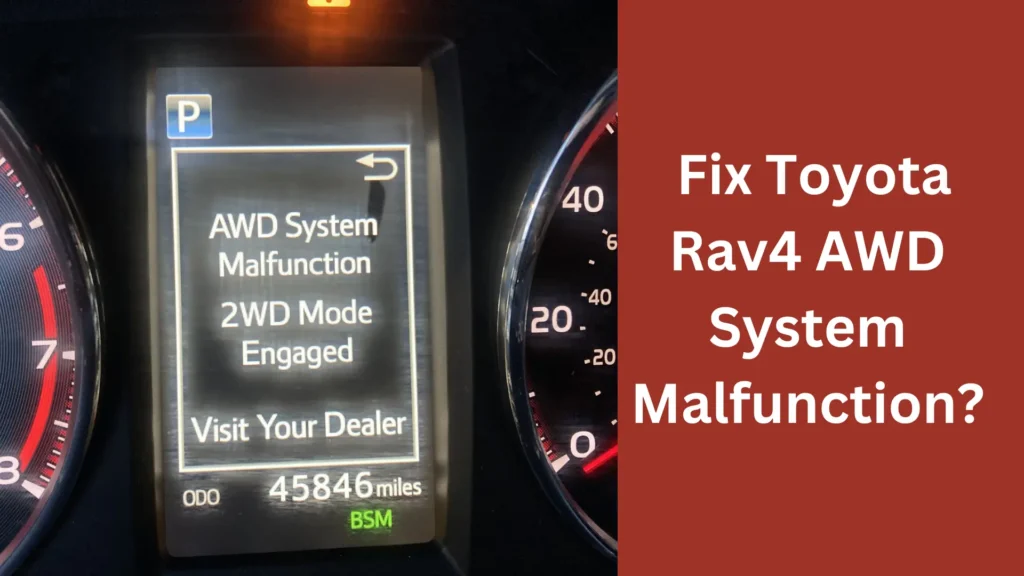Encountering a warning message on your RAV4 can be pretty worrying, especially if it’s about something as important as the all-wheel-drive (AWD) system.
It’s essential to know what might be causing this problem and how to solve it to feel more at ease. Let’s dive into what usually triggers these warnings, why safety is a big concern, and how to fix Toyota Rav4 AWD system malfunction.
What Does It Mean?
When there’s an issue with your Toyota’s AWD system, it’s usually quite noticeable. Your dashboard’s multi-information display, situated between the tachometer and speedometer, will light up with a significant warning message to alert you of the problem.
This message typically reads:
- AWD System Malfunction
- 2WD Mode Engaged
- Visit Your Dealer
This warning serves as the primary signal that something isn’t quite right with your all-wheel-drive setup. Your car’s onboard electronics are designed to detect abnormalities and promptly notify you through this message.
Upon seeing this warning, your AWD system is electronically disabled to prevent further harm. Consequently, your vehicle will operate in two-wheel drive (2WD) mode, meaning only the front wheels are engaged to move your car forward.
As a driver, you didn’t necessarily cause this issue directly. Nonetheless, it’s imperative to take action to rectify the error and ensure your AWD functions smoothly in the future.
Potential Reasons for AWD System Malfunction
This warning message might appear out of the blue for many drivers. Interestingly, it can sometimes pop up following events that seemingly have nothing to do with the AWD system.
Here are a couple of commonly reported triggers for this error, unrelated to an actual problem with the AWD system:
- Battery Depletion and Jump-Starting: If your car’s battery has died and requires a jump-start, it could prompt this warning.
- Loose Gas Cap: Surprisingly, a loose gas cap can also trigger the AWD error message.
- “Check Engine” Light: If the “check engine” light is illuminated on your dashboard, it could be linked to the AWD malfunction warning.
If any of these events have recently occurred, there’s a good chance they’re behind the error message. In such cases, there might not be an issue with your AWD system itself.
However, if none of these scenarios apply to you, it’s advisable to visit a local mechanic to swiftly diagnose and address any underlying issues.
Steps to Resolve the Issue
While it’s true that a loose gas cap can sometimes trigger warning lights and check engine notifications in Toyota vehicles, it may not always be the solution for an AWD malfunction warning.
Typically, you’ll likely need professional assistance from a mechanic or Toyota dealer to pinpoint the root cause of the malfunction. Unfortunately, fixing an AWD System Malfunction isn’t typically a DIY task.
To kickstart the diagnostic process, here are some steps you can take based on the warning lights displayed on your dashboard.
- Check for the “Check Engine” Light: This indicator resembles an engine symbol and might be illuminated on your dashboard. If it’s on, it’s crucial to have your engine error codes checked by a local mechanic, an auto parts store, or a Toyota dealer. Interestingly, the AWD system automatically disables itself when the check engine light comes on, suggesting that the issue might not necessarily lie with the AWD system itself. Alternatively, you can utilize an ODB2 scanner to check the error codes yourself.
- No “Check Engine” Light? If the “check engine” light isn’t illuminated, the situation might be more complex. In such cases, it’s best to take your vehicle to a Toyota dealership to allow them to diagnose and address the problem effectively.
Repair Cost
If your investigation reveals that the AWD malfunction stems from vehicle damage, you’ll need to arrange for repairs.
Predicting the total cost of repairing an AWD system is challenging because it involves several components, and the expenses vary depending on which part is affected.
For instance, repairing an RAV4 driveshaft typically averages around $794, with $699 allocated for parts and $95 for labor. However, replacing an entire transfer case could entail costs ranging from $2,000 to $7,700. These costs fluctuate based on factors such as your location, the model year of your vehicle, and additional considerations.
The most reliable course of action is to consult a local mechanic or Toyota dealership for a precise quote tailored to your vehicle and specific circumstances. They possess the expertise to evaluate any damage accurately and provide an informed estimate for the necessary repairs.
You should also check: Toyota Rav4 TRD Wheels (Explained)
Is it Safe to Drive with AWD System Malfunction?
When a warning light flashes or a message appears on your dashboard, it’s normal to worry about your safety while driving. Questions arise: Can you keep driving? If so, for how long? Should you pull over at the nearest mechanic?
In the case of an AWD system malfunction, driving with the warning displayed is generally considered safe, but you must exercise extra caution behind the wheel.
The warning indicates that the AWD system isn’t functioning correctly, prompting your car to deactivate it as a precaution. Consequently, only the front wheels provide power and propulsion to your vehicle. This setup poses greater risks, especially in slippery conditions like rain or snow, where traction is crucial. Be extra careful, as your vehicle may handle differently than usual.
While it’s safe to continue driving with the AWD disabled, it’s crucial to diagnose and rectify the issue promptly. Operating a vehicle in a compromised state poses inherent risks.
Here’s a guideline to help you determine when it’s safest to drive in 2WD (since your AWD is disabled):
2WD is safe on:
- City streets
- Dry pavement
- Clear roads
2WD is potentially unsafe* on:
- Snow-covered roads
- Ice-covered roads
- Gravel
Although many 2WD vehicles navigate these “potentially unsafe” conditions, it’s essential to recognize that your vehicle may behave differently in these scenarios if the AWD system is malfunctioning.
Conclusion
In conclusion, addressing a Toyota RAV4 AWD system malfunction requires prompt attention and professional assistance. While driving with the warning is generally safe, it’s essential to prioritize repairs to ensure optimal vehicle performance and safety. Consulting a trusted mechanic or Toyota dealership for accurate diagnosis and repairs is crucial for maintaining the reliability and functionality of your vehicle’s AWD system.

